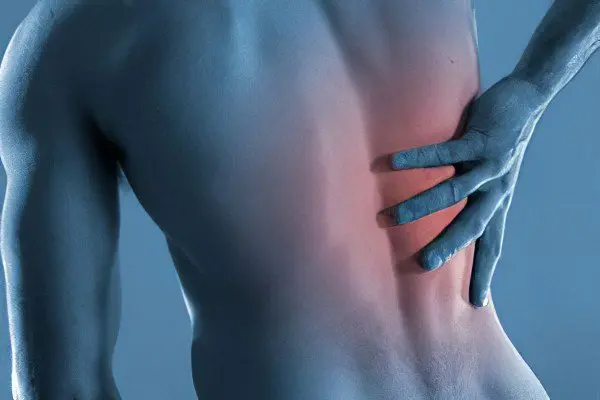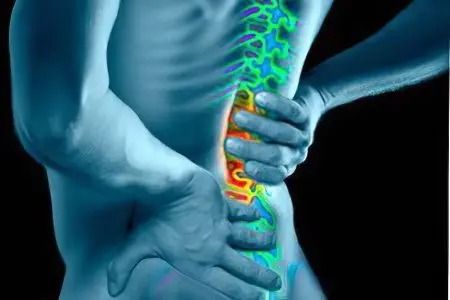Contents
Constant pulling pain in the lower back is a symptom of many diseases, both of the spine and joints, and of internal organs. The human spine bears a large load, the main part of which falls precisely on the lower back. This part of the spinal column is forced to cope with the weight of the body, so it is most often affected. In addition, the intervertebral discs must spring with each step, they can easily be damaged during weight lifting and forward bending of the body.
Types of dull back pain:
Primary low back pain indicates diseases of the spine: changes in the joints, intervertebral discs, ligaments or muscles.
Secondary pain is associated with spinal injuries, tumors, scoliosis, infection, or diseases of the internal organs.
Pain due to diseases of the spine

Back pain suffers from many people who lead a sedentary lifestyle and spend a long time in a sitting position. The appearance of lower back pain is most often associated with damage to the vertebrae, intervertebral disc, pinched nerve or inflammation of the back muscles.
It should not be thought that the occurrence of discomfort in the lumbar region is the result of hypothermia or an uncomfortable body position during sleep. Pain is just the tip of the iceberg. It is necessary to look for the existing pathology of the spine and treat the disease. Otherwise, you run the risk of starting the disease, then the aching pain in the lower back will return again.
The causes of primary aching pain can be the following diseases:
Osteochondrosis is the most common pathology. The disease is characterized by degenerative changes in the intervertebral discs, which eventually lose moisture and flatten. This provokes close contact of the vertebral bodies with each other, which can be deformed.
A herniated disc is a protrusion of cartilage tissue outside the spinal column. With this pathology, pain can gradually increase, give to the leg or back of the thigh.
Spondylolisthesis – displacement of the vertebral bodies relative to each other;
Spondylosis is the formation of spike-like growths along the edges of the vertebrae, which limit their mobility. Over time, due to these overlays, there is a narrowing of the spinal canal and compression of the nerve bundles, which is accompanied by muscle weakness, numbness of the extremities.
In addition to constant aching pain in the lower back, other symptoms may indicate osteochondrosis of the spine:
Numbness of the limbs;
dizziness;
feeling of “goose bumps” on the skin;
noise in ears;
loss of skin sensitivity;
irradiation of pain in the thigh, buttocks, back of the leg or in the groin;
decrease in potency in men;
stiffness and muscle tension in the lumbar region.
Diagnostics

A visit to a competent vertebrologist helps to identify the existing pathology and distinguish osteochondrosis from other diseases. Already at the first stage, by visual examination and palpation, the doctor is able to establish the deformation of the spine, the oblique position of the pelvis and increased tension of the spinal muscles, as well as to get an idea of the mobility of the spine.
With hernias, injuries, the presence or absence of sensitivity, weakness or muscle atrophy is determined. Be sure to check the reflexes, which may decrease in some pathologies.
Sometimes additional research methods are required – tomography, X-ray or MRI. In order not to miss the pathology of the internal organs, blood and urine tests are prescribed, and in some cases a biopsy may be required.
Causes of secondary pain
Women
Women are more likely than men to suffer from pain in the lower back, and this is due to childbearing. During pregnancy, a woman’s spine experiences a serious load due to increased body weight, a shift in the center of gravity, relaxation of muscles and ligaments resulting from hormonal changes. Increasing lower back pain can be a harbinger of an early birth.
Many women complain that they “pull the lower back” in the first days of menstruation, most often the cause is a change in hormonal levels, accumulation of fluid in the tissues, and muscle contractions of the uterus. If there is a physiological deviation of the uterus back, a woman often suffers from pulling pain in the lower back during menstruation.
Diseases of the female genital area can be manifested by dull aching pain in the lower back. If the pain syndrome is constantly present, it is necessary to exclude adnexitis, fibroids, endometriosis, genital infections, ectopic pregnancy.
Be sure to consult a doctor in the following cases:
Bleeding from the vagina is profuse or lasts for a long time;
there was discomfort in the genital area – itching, discharge of an unusual color and smell;
increased body temperature, shivering, aching joints;
lower back pain gradually increases and does not go away.
In men
Men are less likely to suffer from persistent low back pain than women or the elderly. But if she appeared, men experience severe stress. Pain radiates to the groin, genitals, lower abdomen, or leg.
The cause is often prostatitis or prostatic hyperplasia, the urologist will help to make the correct diagnosis. Most often, other symptoms appear: difficulty in urinating, urine output occurs in a weak intermittent stream, sexual weakness develops.
However, aching pain can be a sign of malignant diseases, so you should not delay a visit to the doctor.
After injury

Any falls, bruises, blows to the back can have long-term consequences. Sometimes the result of a blow (dull aching pain in the lumbar region) appears after some time – after a few months or even after a few years, when the person has already managed to forget about the injury. A common type of injury in which the lower back is damaged is a jump or fall from a height with a landing on your feet. This area is affected not only by the mass of the body, but also by the impact force.
Consequences of injury – bruise, dislocation or fracture of the spine. In addition to back pain, there are neurological disorders associated with pinching of the nerves – a disorder of sensitivity, a decrease in muscle strength and reflexes. A prolonged spasm of the paravertebral muscles may occur, which shorten over time, their fibers are replaced by connective tissue.
The sooner the treatment of the injury is started, the greater the chances of a complete recovery of spinal functions.
Pain in the spine in the morning
In some people, more often middle-aged and older, dull aching pain in the back manifests itself in the morning. And it is connected not with an overload of the spine, but, on the contrary, with a long stay in bed. Intervertebral discs absorb fluid and slightly increase in volume. After a nightly recovery, they again experience the weight of the body, flatten out and put pressure on the nerve endings, which is manifested by mild pain in the lumbar region in the morning.
After strenuous exercise
People who work out intensively in the gym often complain of pain in the lumbar region, which is not sharp. Pain is aggravated after body turns, bends and other movements. Most often, their appearance was preceded by a microtrauma of the spine, which is the result of strong physical overload. Excessive zeal in the gym can result in sprains or muscles in the lumbar region, but such pain subsides rather quickly.
Inflammation of the kidneys and urinary tract
Sometimes diseases of the urinary organs are manifested only by a pulling, mild pain in the lumbar region, and without some tests it is quite difficult to make a diagnosis. Temperature fluctuations, chills, general intoxication indicate pyelonephritis or cystitis. Pain in the lumbar region is often unilateral, it intensifies after tapping on the back.
It is possible to suspect diseases of the urinary organs by the appearance of frequent or painful urination, false urges, increased nocturnal diuresis, the release of cloudy urine with flakes and an unpleasant odor. In the analyzes, a large number of leukocytes, bacteria, protein or red blood cells are found.
Urolithiasis disease
The disease begins, as a rule, with an attack of renal colic – a sharp pain to the right or left of the spine. There is a blockage of the urinary tract with a stone, the passage of urine is disturbed, as a result of which it accumulates in the kidneys.
Sometimes a person does not suspect that he has urolithiasis, and only after running, traveling in transport, lifting weights and other physical activity does an acute attack of the disease develop. After the separation of stones with urine, relief occurs.
Diseases of the digestive system
Inflammatory pathology of the internal organs – the pancreas, intestines, gallbladder can make itself felt with prolonged dull pain in the lower back. As a rule, other symptoms also appear – abdominal pain, bloating and heaviness after eating, stool disorders, belching, heartburn. The accumulation of gases in the intestines is characterized by diffuse soreness in the abdomen, as well as in the lower back.
Tumor processes

The cause of pain can be metastases that have penetrated into the bone tissue from other organs – the lungs, thyroid gland, prostate, mammary glands. There are also primary tumor processes that initially develop in the tissues of the spinal column – the spinal cord, its membranes or outgoing nerve bundles.
Pain in oncological pathology increases gradually, starting with a slight soreness, it progresses and becomes quite intense. Pain sensations can be localized along the length of the entire spine or only in a segment of the lumbosacral region, radiate to the leg and thigh, accompanied by impaired sensitivity and muscle weakness. If we add to this a depressed state, weakness, weight loss of patients, then one should resort to an X-ray examination or MRI.
Another malignant lesion of the spine and other bones is multiple myeloma. This is a disease that can occur for a long time without severe symptoms. The tumor clone of cells settles in the bone marrow and further destruction of the bones and tissues of the vertebrae occurs with the occurrence of pathological fractures.
Bechterew’s disease
Another name is ankylosing spondylitis. This is a chronic inflammatory lesion of the joints and spine with a tendency to restrict movement. The first symptoms may be nocturnal lower back pain, subsiding in the morning, when a person’s physical activity begins. Unfortunately, the disease at an early stage is not always possible to identify. Once diagnosed, the disease is difficult to treat.
The disease manifests itself as unsharp pains in the lumbar or lumbosacral region, so a person turns to a neurologist and is treated for sciatica for a long time. The inflammatory process gets further spread and ends with the immobility of the spine and such a pronounced stoop that a person can only move in a half-bent state.
Which doctor should I contact with constant pain?
The following specialists will be able to determine the cause of the pain syndrome:
Neurologist;
Orthopedist;
Gynecologist;
Urologist;
Gastroenterologist;
Vertebrologist;
Rheumatologist;
Infectious disease.
In case of falls and bruises of the spine, of course, you should contact the trauma center.
Pain treatment
In the arsenal of neurologists and orthopedists, there are numerous methods to cope with pain in osteochondrosis. Manual therapy can bring great relief, as well as massage, reflexology, leech treatment, and physiotherapy methods. In parallel, the doctor may prescribe anti-inflammatory and analgesic drugs used in tablets or in the form of injections.
As the patient’s condition improves, physiotherapy exercises begin, which helps to slow down the further development of degenerative processes in the spine.
Treatment of diseases of other organs should be carried out by an appropriate specialist.









